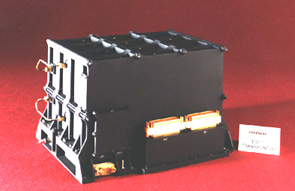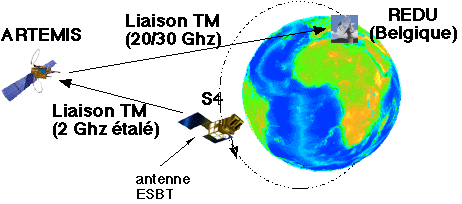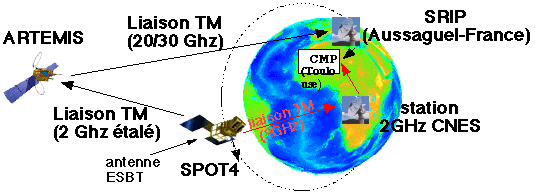 The ESBT passenger is a "spread-spectrum" transponder (i.e. a combined transmitter and
receiver) operating in the 2-GHz band, also known as the S-band. The ESBT was produced by
Alcatel Espace under an ESA contract.
The ESBT passenger is a "spread-spectrum" transponder (i.e. a combined transmitter and
receiver) operating in the 2-GHz band, also known as the S-band. The ESBT was produced by
Alcatel Espace under an ESA contract. The ESBT passenger is a "spread-spectrum" transponder (i.e. a combined transmitter and
receiver) operating in the 2-GHz band, also known as the S-band. The ESBT was produced by
Alcatel Espace under an ESA contract.
The ESBT passenger is a "spread-spectrum" transponder (i.e. a combined transmitter and
receiver) operating in the 2-GHz band, also known as the S-band. The ESBT was produced by
Alcatel Espace under an ESA contract.
ESBT is an experimental prototype designed to test intersatellite links, in this case
between SPOT 4 in low-earth orbit and the Artemis telecommunication satellite in
geostationary orbit. The package will provide experimental telemetry and command links
between SPOT 4 and the Artemis ground segment in Redu, Belgium.
The ESBT passenger comprises:
 The ESBT is independent of the host satellite's mission, its only direct
contact with the Spot system being through the SPOT 4 operations control centre, or
CMP. Commands uplinked to SPOT 4 by the CMP via the ESBT are not actually used by the
satellite; nor is the telemetry downlink used as a nominal, operational capability.
Rather, the ESBT's main mission is to assess the quality of the low-data-rate (4 kbit/s)
forward and return links (i.e. command uplink and telemetry downlink, respectively)
between the experimental Artemis ground segment, acting as a dummy CMP, and SPOT 4.
These experiments will be entirely managed by the ESA station in Redu, Belgium, without
the least involvement of the SPOT 4 CMP, save for the programming of orbital slots
during which the ESBT may be switched on. The Redu station will also evaluate the quality
of range data generated using the ESBT.
The ESBT is independent of the host satellite's mission, its only direct
contact with the Spot system being through the SPOT 4 operations control centre, or
CMP. Commands uplinked to SPOT 4 by the CMP via the ESBT are not actually used by the
satellite; nor is the telemetry downlink used as a nominal, operational capability.
Rather, the ESBT's main mission is to assess the quality of the low-data-rate (4 kbit/s)
forward and return links (i.e. command uplink and telemetry downlink, respectively)
between the experimental Artemis ground segment, acting as a dummy CMP, and SPOT 4.
These experiments will be entirely managed by the ESA station in Redu, Belgium, without
the least involvement of the SPOT 4 CMP, save for the programming of orbital slots
during which the ESBT may be switched on. The Redu station will also evaluate the quality
of range data generated using the ESBT.
 In addition to these experiments, the ESBT will, however, be used
operationally to relay SPOT 4 housekeeping telemetry via Artemis to the SPOT 4
CMP, the Artemis downlinked being received by the SRIP (station for receiving imagery via
Pastel) facility at Aussaguel, 20 km from Toulouse.
In addition to these experiments, the ESBT will, however, be used
operationally to relay SPOT 4 housekeeping telemetry via Artemis to the SPOT 4
CMP, the Artemis downlinked being received by the SRIP (station for receiving imagery via
Pastel) facility at Aussaguel, 20 km from Toulouse.
This capability will significantly enhance the SPOT 4's housekeeping telemetry coverage. Whereas each station in the CNES TT&C network provides just 10 to 15 minutes' contact time per pass, the ESBT will offer 30 to 40 minutes continuous contact as a result of the considerably longer periods of contact between SPOT 4 and Artemis (and considerably longer periods of contact between SPOT 4 and Artemis). This will be a major step forward, particularly when monitoring onboard operations that must be watched closely and continuously (e.g. during recovery operations after a period in safe mode).
The spread-spectrum technique involves mixing a useful digital signal (here at 4 kbit/s) with a complex pseudo-random code (in this case at 3 Mbit/s).
Advantages include:
The interface with the ground segment uses a modulator/demodulator, or modem, similar to those used to connect a computer to a telephone line, produced by Finnish company Elektrobit. Modems have been installed at both the Redu station in Belgium and at the SRIP station at Aussaguel.
The ESBT technology is expected to find important applications in manned space programmes (shuttles, capsules, space stations, etc.) where reliable, long-term links are essential and even vital.
![]()
page updated on the 00-06-06